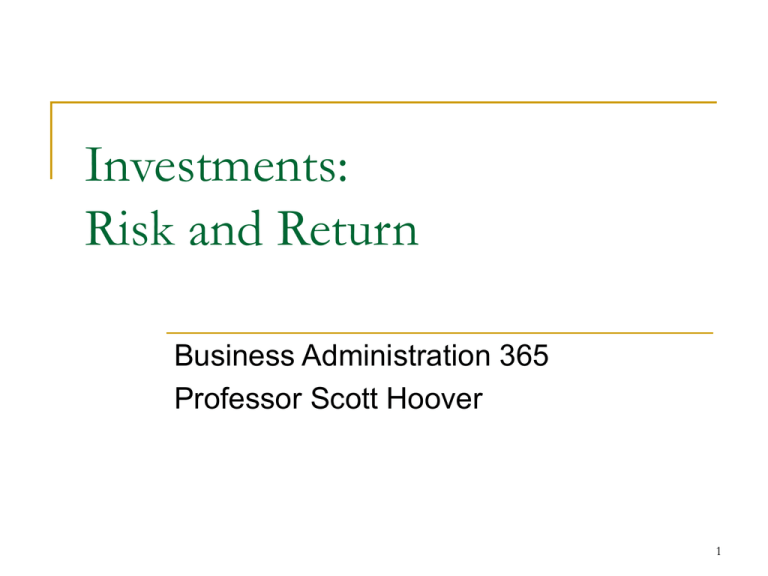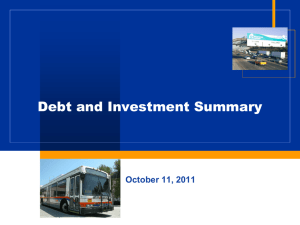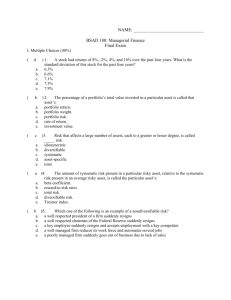The Risk-Return Relationship
advertisement

Investments: Risk and Return Business Administration 365 Professor Scott Hoover 1 Returns Return measure of the benefit received from an investment holding period return % change in value over the period effective annual return (EAR) 1-year holding period return includes the effects of compounding. annual percentage rate (APR) per period rate × # of periods per year ignores the effects of compounding 2 If rp is the per period rate and m is the # of compounding periods per year, APR m rp EAR (1 rp ) m - 1 Putting those together gives m APR EAR 1 -1 m The distinction is important because… Annual discount rates must be EARs Banks quote APRs Bond yield-to-maturities (YTMs) are APRs Credit cards and option valuation models use continuouslycompounded interest rates APRs with m = ∞ 3 A few examples… A bank quotes 9% APR, compounded monthly. A bond pays 4% interest every six months. Per period rate 9%/12 = 0.75% EAR = 1.007512 - 1 = 9.38% YTM = 4%×2 = 8% EAR = 1.042 - 1 = 8.16% The continuously-compounded interest rate is 6% per year. What happens as m gets bigger? m = 10 → EAR = 6.165% m = 100 → EAR = 6.182% m = 1000 → EAR = 6.183% m = ∞ → EAR = 6.184% m APR APR EAR lim 1 - 1 e 1 m m 4 Risk Risk measure of the potential for loss in an investment How should we measure risk? Reality: we really don’t know how to best measure risk. What do we know about risk? Some risk is all but eliminated in well-diversified portfolios diversifiable risk (aka, idiosyncratic risk, firm-specific risk) Some risk remains no matter how well-diversified we are non-diversifiable risk (aka, systematic risk, market risk) 5 Capital Asset Pricing Model (CAPM) Intuition: Investors will only be compensated for the level of non-diversifiable risk they take on. Why? Definition: market portfolio ≡ portfolio of all assets weighted according to their market values. Result Expected return on a well-diversified portfolio is a linear function of the standard deviation of the portfolio’s returns Why is std. dev. a reasonable measure here? The line is called the Capital Market Line (CML) E(R) = Rf + (/ m)(E(Rm)-Rf) R return on portfolio Rm return on market portfolio Rf risk-free return std. dev. of portfolio m std. dev. of market portfolio 6 Expected Return Capital Market Line E(Rm) Rf m Risk (standard deviation) 7 The CML is useful for well-diversified portfolios, but not for individual assets. To eliminate diversifiable risk, we extract the portion of the standard deviation that is correlated with the market. This leaves b, which is our measure of the non-diversifiable risk of an asset. COV R, Rm r m r b 2 VARRm m m r ≡ correlation between asset returns and market returns Result: expected return on any asset is a linear function of b. This line is called the Security Market Line (SML) E(R) = Rf + b(E(Rm)-Rf) 8 Expected Return Security Market Line E(Rm) Rf 1 Risk (beta) 9 Roughly speaking, beta tells us how the asset price tends to move when the market moves. e.g., Suppose b=1.5 for some asset. The asset will tend to move by 15% whenever the market moves by 10%. Do assets with negative betas exist? After all, E(R) < Rf Yes! Such assets provide insurance on the portfolio 10 Miscellaneous Notes If markets are efficient, investing is nothing more than choosing a b and a method to achieve it. invest in a combination of the risk-free and a market index Portfolio betas The beta of a portfolio is the weighted average of the betas of the individual assets in the portfolio: bp = wAbA + wBbB + … The weights are the fraction of our money we have invested in each, with short positions having negative weights example: Suppose we have $10,000 to invest and that we short $6,000 of one asset. We then invest $16,000 into a second asset. w1 = -$6,000/$10,000 = -0.6 w2 = $16,000/$10,000 = 1.6 11 Problems with using the CAPM What is the market portfolio? can include every conceivable asset (stocks, bonds, baseball cards, ostrich eggs, etc.). difficult to measure, so we proxy by using a market index (such as the S&P500 or the Russell 3000). expected return on the market portfolio is difficult to estimate. def’n: market risk premium (MRP) = E(Rm)-Rf One study shows that the MRP was about 7.4% from 1926-1999. Recent evidence suggests that it should be around 4%. 12 Other factors may be important. Historical returns may not be representative of future returns. What if we don’t have historical data for the asset? See spreadsheet example find comparables use common sense Bottom Line: use the CAPM and common sense to estimate the appropriate discount rate 13 Applying the CAPM gives the appropriate rate for discounting cash flows to shareholders used as part of the WACC calculation WACC = wdRd(1-T) + wpsRps + weRe Recall that wi fraction of firm (using mkt values) financed with type i T tax rate Re required return on equity estimated using CAPM Rps required return on preferred stock estimated using D/P Rd required return on debt 14 Techniques to estimate cost of debt #1: Find the yield-to-maturity on the company’s outstanding debt Potential problems 1. YTM depends on the maturity of the debt. If the company’s debt has a very long or very short maturity, our estimate may be biased. 2. The YTM does not reflect the expected return to investors. 3. The company’s debt may not be publicly-traded 4. Bonds with embedded options are problematic. 15 #2: Use the company’s debt rating in conjunction with yield spreads to estimate the company’s cost of debt. yield spread: the difference between the yield on a bond (or class of bonds) and a corresponding Treasury bond with the same maturity example: Suppose a company’s debt is rated Baa1 by Moody’s. What is our best estimate of the company’s cost of debt? Suppose we choose to use a ten-year maturity for our estimates. From www.bondsonline.com, we see that the yield spread is 107 basis points, or 1.07%. (Note that this is an old estimate). From www.cnnfn.com, we see that ten-year Treasuries have a yield of 3.89% Cost of debt estimate = 3.89%+1.07% = 4.96% 16 Potential problems The company’s debt may not be rated The bond may not be an average bond within its ratings class. #3: Find the cost of debt on comparable companies 17






